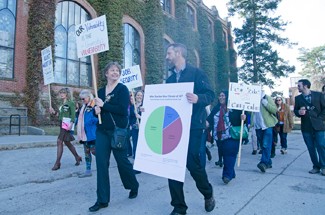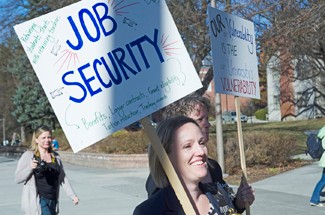UI adjunct faculty protest against working conditions
More than 30 University of Idaho faculty, staff, students and supporters marched to the Administration Building in protest of the working conditions for adjunct faculty Wednesday afternoon.
The march was part of the first-ever National Adjunct Faculty Walkout Day. Across the country, protests were held at college campuses to bring attention to the problems facing adjunct faculty.

Nathan Romans | Argonaut
UI adjunct faculty march in front of the Administration Building Wednesday to observe National Adjunct
Walkout Day. Protestors sought to raise awareness of contingent faculty working conditions.
“This problem of contingent faculty is a problem of education,” said Terry Lingrey, an English lecturer and protest organizer. “If one area is devalued, all of it is. It hurts everyone, not just teachers.”
Many adjunct, also know as contingent, faculty at UI are hired on a per semester, per course basis. For the UI English Department, teaching as a contingent or temporary lecturer pays $4,000-$4,500 per course, with a maximum of four courses taught. Some contingent faculty are not offered the same employee benefits as other UI faculty — including qualifying for health care, tenure, retirement plans, sick leave, life insurance and tuition reduction.
“What it means is that I have no ability to plan for the future, because I don’t have a permanent state here,” Lingrey said. “If there are not enough courses for me, I may have to turn them down in order to find a job that actually pays a living wage.”
The march marked the end of a daylong protest planned by contingent faculty of the English Department to raise awareness of the working conditions contingent faculty face. Starting at 9 a.m., protest organizers and supporters gathered in the Idaho Commons rotunda to grade papers, do homework and answer questions about the issue. Some of the protesting faculty members fastened pins to their shirts that read, “Adjunct.”
Kelly Roberts, an English lecturer and protest organizer, said the response from students and faculty was largely positive. Many people were surprised to learn about the differences between contingent and non-contingent faculty, she said.

Nathan Romans | Argonaut
Contingent faculty marches from the Commons Rotunda, where they held a “grade-in,” to the office of CLASS Dean Andrew Kersten’s in protest of adjunct faculty’s rights at 2 p.m. Wednesday.
UI Interim Provost and Executive Vice President Katherine Aiken said the quality of teaching is high at UI, regardless of tenure status. In fact, Aiken said she agrees with the contingent faculty who protested Wednesday.
“These people who are engaged in this action are exactly right,” Aiken said. “They’re highly qualified and talented classroom instructors who make a big contribution to the University of Idaho.”
Students and teachers were encouraged to walk out of classrooms or to wear insignias to support the protest. Those who attended the “grade-in” could sign a statement of support calling for improved benefits for contingent faculty.
Jeff Jones, a lecturer for the English Department and one of the protest organizers, said the decision to stage a “grade-in” and protest march, instead of another form of demonstration, was to avoid harming students.
“We wanted to get the administration’s attention, but we wanted to do it in a positive way,” Jones said.
The demonstrators marched to the Administration Building to protest the inability to meet with Andrew Kersten, dean of the College of Letters, Arts and Social Sciences.
Jones said despite requesting a meeting to discuss contingent faculty concerns in January for the day of the National Adjunct Walkout, the Dean’s office suggested it be pushed back to April.
“April seems like a long time away when your contract is done in May,” Jones said.
When the protesters reached Kersten’s office, they gathered silently inside. Jones handed an enlarged pie chart depicting the ratio of teachers for General Education English classes and a “Declaration of Inequality” to Jennie Hall, assistant to the dean.
After Jones handed both documents to Hall, she confirmed a new Tuesday meeting time with Kersten to discuss contingent faculty concerns.
Being part of contingent faculty comes with a feeling of vulnerability, Jones said. Since contingent faculty can be easily fired, he said the impulse to not protest their working conditions is strong.
“(Contingent faculty) are the fast food workers of the university,” he said. “We are the illegal immigrants. We are the undocumented workers at the university.”

Nathan Romans | Argonaut
English Department Lecturer Jeff Jones hands a protest poster to CLASS Assistant to the Dean Jennie Hall after the contingent faculty marched from the Commons Rotunda in protest of adjunct faculty rights at 2 p.m. Wednesday.
According to the Rhetoric-Composition Committee for the UI Department of English, 52 percent of General Education English classes were taught by temporary lecturers in 2013. A 2014 report by the American Association of University Professors found that 76.4 percent of U.S. faculty across all institutional types were adjuncts.
Lower state funding for higher education and rising expenses are some of the reasons for the high amount of contingent faculty in higher education, Aiken said.
“For most students in a classroom, you can’t tell the difference between any of these kinds of faculty because the quality of the instruction and the classroom experience is very high,” Aiken said.
The protest sought to add changes to the careers of contingent faculty, Jones said. In the Declaration of Inequality, some of the proposed revisions include nine-month contracts, a full reinstatement of employee benefits, possibilities for promotion and being considered permanent faculty after three years of employment.
“All of those things have a financial implication, at a time we are trying to keep control of our tuition and other expenses,” Aiken said. “Were we to do any or all of those things that would mean we would have to reduce expenditures somewhere else in order to accomplish that. That’s not saying that isn’t something we wouldn’t consider, but that’s what we would have to take into account.”
For Jones, many of the issues UI is currently grappling with could be aided by investing in contingent faculty. He said the success of an institution could be measured by the way it treats its community, from students to teachers of all classifications.
“The question is ‘How much does the university want to invest in its people?'” Jones said. “They talk a lot about … recruiting good students and retaining them. Retaining students starts with retaining teachers.”
Aleya Ericson can be reached at [email protected]

